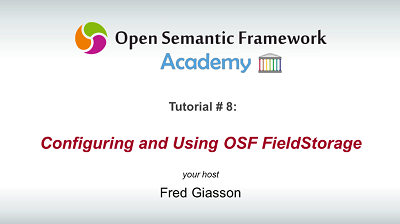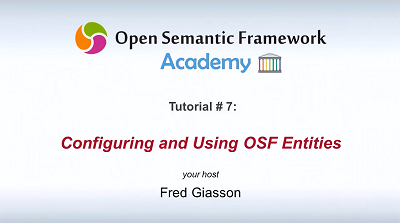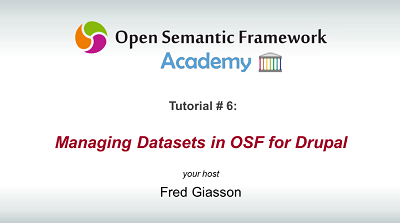This screencast introduces you to another one of the most important OSF for Drupal connector: the OSF FieldStorage module. What this module does is to create a new FieldStorage type for Drupal7. It enables Drupal7 to save the values of its Content Types fields into another storage system than the default one (i.e MySQL in most of the cases).
Because of the way that the Field system has been designed in Drupal7, it is possible to save the values of different fields that compose the same Content Type bundle into different field storage system. For example, if your Content Type bundle is composed of 10 fields, then 4 of them could be saved into MySQL and 6 of them into OSF.
The main purpose of the OSF FieldStorage module is to be able to save Drupal local Content Type information into OSF. What that means is that all your Drupal7 local content then become accessible, manageable and manipulatable using the 27 Open Semantic Framework (OSF) web services endpoints. Your local Drupal content can then be shared with other Drupal instances that could use OSF for Drupal to connect to that same OSF instance and seamlessly republish/re-purpose that local content from the other Drupal portal.
Here is the documentation of the architecture of this connector module.
This is the power of the OSF FieldStorage connector module. It supports the following Drupal features:
- Full FieldStorage API
- Entities caching
- Revisioning
- SearchAPI
- 29 field widgets
- Export feature in 6 formats
In this screencast, you will be introduced to Drupal7’s Field system. Then you will see how the OSF FieldStorage module creates a new FieldStorage type for Drupal7 and how it can be used. Then you will see how to configure the OSF FieldStorage module: to creating new Content Type fields that uses this osf_fieldstorage type, how to map these fields to RDF, how to use one of the 29 supported field widgets, etc.
Finally, you will see how you can synchronize existing Content Type pages (that was created before OSF for Drupal was installed on your Drupal instance) into a OSF instance.




